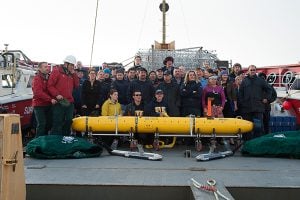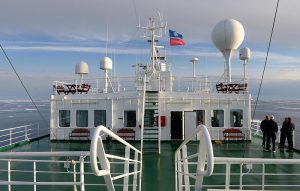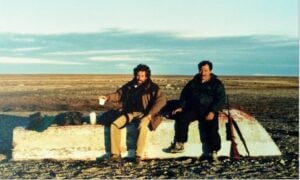
History
2014 Victoria Strait Expedition
This year's search is about much more than underwater archaeology. The Victoria Strait Expedition will contribute to northern science and communities.
- 1205 words
- 5 minutes
This article is over 5 years old and may contain outdated information.
History

Aboard the RV Martin Bergmann
While searching the Queen Maud Gulf for signs of Sir John Franklin’s lost ships, HMS Erebus and HMS Terror, the Arctic Research Foundation’s Martin Bergmann hit a previously unknown shoal early Wednesday morning.
“Most of the work we do in the Arctic takes place in uncharted waters,” says Parks Canada archeologist Thierry Boyer. “Hitting a shoal is always a risk. It’s part of the job. We know it can happen, and yesterday it did.”
The research vessel was lodged on the shoal for two-and-a-half hours, and Coast Guard icebreaker Sir Wilfrid Laurier was contacted to provide assistance before the Martin Bergmann’s crew managed to free the ship using its anchor as a winch, with additional towing capacity provided by two skiffs kept on board for use in archeological surveying. During the attempt to dislodge the ship from the shoal, crewmember Shane Milmore went overboard. He was quickly pulled to safety by Brandon Patey, a fellow crewmember. No injuries were sustained during the effort.
In recent days, the Martin Bergmann has been searching particularly treacherous waters for the wrecks of Franklin’s ships. Numerous shoals have forced co-captains Gerry Chidley and David McIsaac to divert their ship’s planned course to avoid shallow waters. Still, the team managed to successfully survey 1,295 linear kilometres on its most recent mission, and this year’s survey should again cover more ground than any previous search.
“We were cruising along at a depth of more than 15 metres, and we pretty much hit a wall,” says Yves Bernard, a Royal Canadian Navy petty officer who was operating the ship’s sonar just after 4 a.m. on Wednesday morning, when the incident occurred. “It came up on us really fast. We hit 10 metres, and we started to turn, then all of a sudden we were sitting in less than two metres of water on a shoal.”
Assessments made immediately following the incident indicate the ship did not sustain any major damage. It is not taking on water, and its steering mechanism — of critical importance to underwater archeological surveying — appears to have been unaffected. The ship is now returning to port at Cambridge Bay, where divers will inspect the ship to gain a clearer picture of any damage that may have been sustained in the incident. While in port, the Martin Bergmann will be resupplying and waiting out a forecast storm before it continues to the Victoria Strait to resume the search.
Updates were made to this story on Sept. 5, 2014.
Are you passionate about Canadian geography?
You can support Canadian Geographic in 3 ways:

History
This year's search is about much more than underwater archaeology. The Victoria Strait Expedition will contribute to northern science and communities.

History
Why this summer’s search for the lost ships of the Franklin Expedition will be the biggest and most advanced ever

History
First official day of the 2014 search for Sir John Franklin’s lost ships

History
Arctic historian Ken McGoogan takes an in-depth, contemporary perspective on the legacy of Sir John Franklin, offering a new explanation of the famous Northern mystery